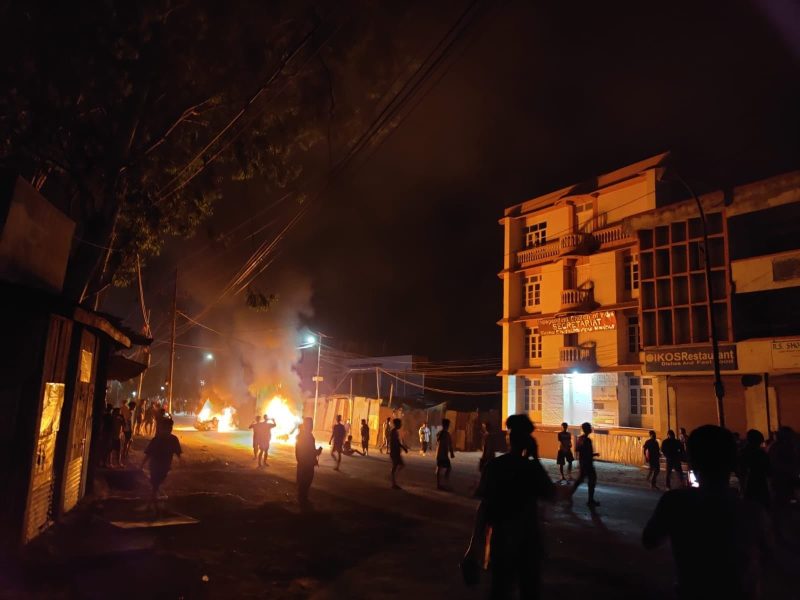
Manipur: Ethnic divide widens with tribal groups sticking to their stands

Manipur appears to be normal, with no major incidence of violence taking place in the last couple of days.
But beneath the veneer of calm, there is a deepening chasm with tribal communities who are at the centre of recent Kuki-Meitei clashes claiming that “nothing short of a Union territory status” will “protect” their rights and “give security” to their people.
A decision to this effect was taken during a series of consultative meetings civil society organisations (CSOs) representing Kuki-Zomi-Hmar and other tribes from the same ethnic stock and 10 Manipur legislators belonging to these communities held in the Mizoram capital Aizawl since Tuesday evening.
They had a threadbare discussion on the current situation in Manipur and the steps the community should take to chart their future course.
“A separate administration for the hill areas of Manipur that we have asked for should not be anything less than UT-status,” general secretary of the Kuki Inpi Churachandpur Lalkhohao Chongloi told The Federal over phone from Aizawl.
Boycott Biren Singh
He said the meeting further decided to form an “United Front” to press for their demand, snapping all ties with the Biren Singh-led Manipur government.
The meeting called all members of the communities, including government servants, who are still staying in Meitei-dominated Imphal Valley, to return to the hills within three days.
“There are about 200 of our people who are still in the valley. We want them to return to the hills without any further delay for their safety and security,” Chongloi said.
Also Read: Explained: What is Article 355 that has been imposed in Manipur
The 10 MLAs, in a three-page letter to Union Home Minister Amit Shah, had first placed the demand for a separate administration on May 15. At that time, they had stated that their people had lost faith in the Manipur government as they believed it “tacitly” supported violence unleashed on them.
Similar sentiments were reportedly echoed in the Aizawl meet. The mistrust vis-a-vis the state government is so deep that the organisations did not even feel secure to hold their consultative meetings in Manipur.
Why Mizoram?
“It was not safe to hold such broad discussions within Manipur due to the possibility of a crackdown from the Manipur government. So, we decided to meet in Mizoram as we share blood relation with the people here,” the Kuki leader said.
Three of the rebel MLAs from Manipur met Mizoram Chief Minister Zoramthanga on Friday morning. They, however, did not divulge the contents of their discussions.
Zoramthanga had earlier said his government and the people of Mizoram would not be a mute spectator to the turn of events and violence in Manipur.
Earlier, the demand of the legislators had sparked protests in various valley districts of Manipur calling for a “territorial integrity” of the state.
The MLAs, however, did not spell out to the home minister then as to what would be the contour of the separate administration as a section within the communities even favoured reviving an old demand for a “Greater Mizoram”.
After marathon meetings in Aizawl, it was decided not to rake up that demand and instead call for a separate state or UT status comprising all the hill areas of Manipur including the Naga-inhabited areas.
“Some groups had raised the demand for inclusion of our territory within the state of Mizoram. But after hectic consultations it was unanimously decided that such a demand would not be appropriate at this juncture,” Chongloi said after the meeting.
MNF & Manipur
During the height of the insurgency, Mizo National Front (MNF) leader Laldenga had raised the demand for inclusion of contiguous Mizo-dominated territories of Manipur, Tripura and Assam within Mizoram.
Kuki-Zomi-Hmar and their sub-tribes are part of the larger Mizo generic tribe. Hence, Laldenga wanted all the territories inhabited by these groups to be brought under one administrative umbrella of Mizoram.
He later dropped the idea during peace negotiations with the then Congress government headed by Rajiv Gandhi to expedite the peace process.
Following the recent violence, the old demand had again gained some attention in the Kuki-dominated areas. But after broad consultations, the communities decided not to push for it.
Instead, they decided to hold wider “consultations” with all stakeholders of the hill areas of Manipur, including the Naga communities, for a common administrative entity with UT or statehood status comprising entire hill areas of Manipur that constitute 90 per cent of the state’s territory.
“We will be soon holding parleys with Naga communities about our demand,” the Kuki Inpi leader disclosed.
It will be interesting to see how Naga civil society organisations react to this demand.
Naga stand
At a recent closed-door meeting, community-based tribal organisations of Naga areas of Manipur decided to maintain “neutrality” in the current conflict.
The inclusion of Naga-dominated districts of Manipur with the present state of Nagaland is one of the demands of the National Socialist Council of Nagalim (NSCN), the insurgent group which is currently in peace parleys with the Centre to hammer out a “permanent solution” to the seven-decades-old Naga political problem.
The latest separation demand will only increase the valley-hills divide in Manipur.
It is high time the Centre intervened to initiate a reconciliation process between the warring communities.


